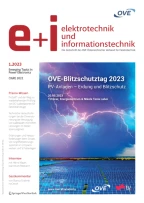Abstract
In recent years, Austrian Power Grid AG (APG) has successfully introduced dynamic line rating for the weather-dependent determination of the current-carrying capacity on various overhead lines. The higher current loading of overhead lines also increases the current loading in substations. In some cases busbars appear to be the new limiting element.
As weather-dependent operation of tubular busbars is not yet in practice, a physical model working in a similar way as dynamic rating for overhead lines has been developed and evaluated. Due to the significantly larger surface area of tubular busbars compared to conductors of overhead lines, radiation as well as absorption and convection have a greater influence on the current-carrying capacity of tubular busbars than of conductors of overhead lines.
Calculations of the current-carrying capacity of a tubular busbar based on the weather data over one year show that the current-carrying capacity can be regularly increased by several ten percentage points.
In the near future, dynamic rating will be used for tubular busbars at APG in network operation to be able to significantly increase the current-carrying capacity of busbars in suitable ambient conditions.
References
Coneybeer, R. T., Black, W. Z., Bush, R. A. (1994): Steady-state and transient ampacity of bus bar. IEEE Trans. Power Deliv., 9(4), 1822–1829.
DIN 43 670 (Aluminium bus bars, design for continuous current) (12/1975), identically in Austria as ÖNORM. DIN 43670 (05/1978).
Prager, M., et al. (1976): Thermal considerations for outdoor busbar conductor design. IEEE Trans. Power Appar. Syst., PAS95(4), July/August.
Prager, M., et al. (1977): Thermal considerations for outdoor busbar conductor design – ampacity tables. IEEE Trans. Power Appar. Syst., PAS96(4), July/August.
Rigdon, W. S., House, H. E., Grosh, R. J., Cottingham, W. B. (1962): Emissivity of weathered conductors after service in rural and industrial environments. Trans. Am. Inst. Electr. Eng., 3, Power Appar. Syst., 81(3), 891–896.
Webs, A. (1963): Dauerstrombelastbarkeit von nach DIN 48201 gefertigten Freileitungsseilen aus Kupfer, Aluminium und Aldrey. Elektrizitätswirtschaft, 62(23).
Cigré TB 207 (2002): Thermal behaviour of overhead conductors. August.
Cigré TB 601 (2014): Guide for thermal rating calculations for overhead lines. December.
Aluminum Association Inc. (1989): Aluminum electrical conductor handbook. 3rd ed. Part 1 compressed.
Author information
Authors and Affiliations
Corresponding author
Additional information
Publisher’s Note
Springer Nature remains neutral with regard to jurisdictional claims in published maps and institutional affiliations.
Paper submitted for the CIGRE Session 2020, SC-B3, August 25, 2020, online.
Rights and permissions
About this article
Cite this article
Reich, K., Weissnar, R. & Puffer, R. Investigation of the dynamic rating of tubular busbars in substations. Elektrotech. Inftech. 137, 455–459 (2020). https://doi.org/10.1007/s00502-020-00847-0
Published:
Issue Date:
DOI: https://doi.org/10.1007/s00502-020-00847-0
